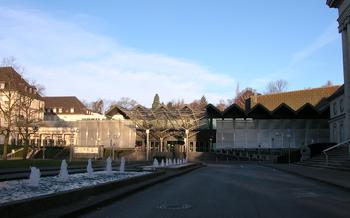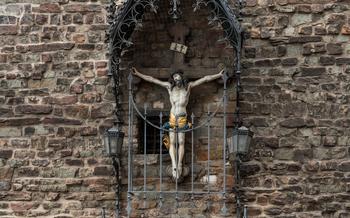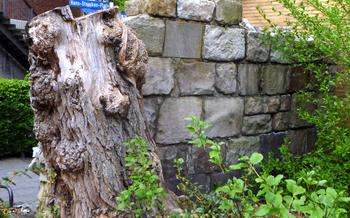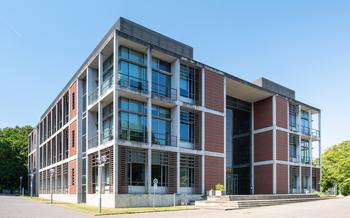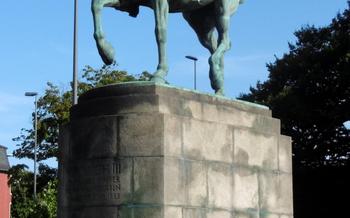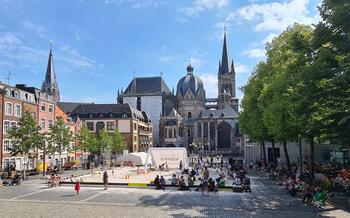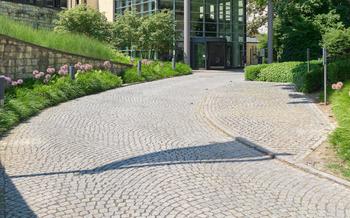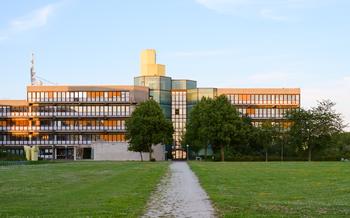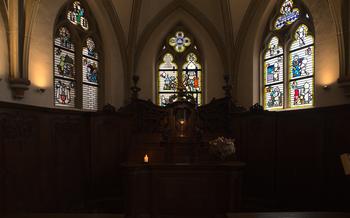
Klenkes Monument
- Aachen Cathedral: A Majestic Symbol of Imperial History
- Klenkes Monument
- Elisenbrunnen
- History and Origin of the Elisenbrunnen Mineral Spring
- Architectural Features and Design of the Fountain Structure
- Health Benefits and Healing Properties Attributed to the Spring Water
- Practical Information for Visiting
- Aachen Rathaus
- Suermondt-Ludwig-Museum: A Journey Through Art History
- CHIO Aachen: A Celebration of Equestrian Excellence
- Dreilaendereck: Where Three Countries Meet
- Lousberg Hill: A Scenic Panorama and Historical Gem
- Aachen Christmas Market
- Ponttor: A Majestic Gateway to Aachen's Past
- Couven Museum: A Journey Through Aachen's Past
- Insider Tip: Unveiling Aachen's Hidden Gems
Aachen Cathedral: A Majestic Symbol of Imperial History
In the heart of Aachen, Germany, stands a magnificent monument to faith, history, and architectural prowess—the Aachen Cathedral. This towering edifice, with its rich tapestry of religious and imperial significance, has served as a spiritual beacon and a testament to artistic brilliance for over 1,200 years.
Originally constructed by Charlemagne, the illustrious emperor of the Holy Roman Empire, the Aachen Cathedral holds a prominent place in European history. Charlemagne's vision for a grand imperial basilica was realized in this awe-inspiring structure, which became his chosen place of worship and burial. Over the centuries, the cathedral witnessed the coronations of numerous Holy Roman Emperors, solidifying its role as a symbol of imperial power and prestige.
Architecturally, the Aachen Cathedral is a fusion of Romanesque and Gothic styles, showcasing exquisite craftsmanship and intricate details. Its octagonal dome, a hallmark of Carolingian architecture, soars above the city skyline, while its interior boasts a harmonious blend of arches, columns, and stained glass windows. The cathedral's treasury is a treasure trove of religious artifacts, including the famed Karlsschrein, a lavish reliquary housing the remains of Charlemagne and other imperial figures.
Visiting the Aachen Cathedral is a journey through time, where the echoes of history reverberate within its hallowed halls. Whether you're a history buff, an architecture enthusiast, or a pilgrim seeking spiritual solace, this majestic cathedral promises an awe-inspiring experience that will leave an enduring mark on your soul.
Klenkes Monument
Description and Design:
Located in the heart of Aachen, the Klenkes Monument is a quirky and captivating sculpture that pays homage to the city's traditions and its unique dialect. The bronze statue, unveiled in 1970, depicts a mischievous-looking boy named "Klenkes," who is portrayed as a street urchin with a mischievous grin and a mischievous gesture. The statue stands at around 5 feet tall and is situated on a granite pedestal, making it a prominent and eye-catching feature in the city center.
Historical Context:
The creation of the Klenkes Monument was inspired by the local folklore and dialect of Aachen. The term "Klenkes" is a colloquial expression used to describe a mischievous or cheeky person, and the statue aims to capture the spirit of the city's residents, known for their playful and lighthearted nature.
Cultural Significance:
The Klenkes Monument holds significant cultural value for the people of Aachen. It serves as a symbol of the city's unique identity and its strong sense of community. The statue has become a beloved landmark and a source of pride for the locals, who often gather around it to share stories and celebrate their shared history.
Location:
The Klenkes Monument is strategically placed in the Marktplatz, the central square of Aachen. It is situated in close proximity to other notable landmarks, such as the Aachen Cathedral and the Rathaus, making it an integral part of the city's historical and cultural landscape. Visitors can easily find the monument by heading to the Marktplatz and looking for the bronze statue of the mischievous boy.
Elisenbrunnen
History and Origin of the Elisenbrunnen Mineral Spring
The Elisenbrunnen, a renowned mineral spring in Aachen, Germany, holds a significant place in the city's history and culture. Its origins date back to the 14th century when a mineral-rich spring was discovered in the area. Over time, the spring gained popularity for its purported healing properties and became a popular destination for locals and visitors alike.
Architectural Features and Design of the Fountain Structure
In 1827, the Elisenbrunnen was adorned with an elaborate fountain structure designed by the renowned architect Karl Friedrich Schinkel. The fountain, featuring a grand rotunda with Ionic columns and a central basin, quickly became an iconic landmark of Aachen. The rotunda's elegant design, complemented by intricate sculptures and reliefs, reflects the architectural style of the era and adds to the charm of the Elisenbrunnen.
Health Benefits and Healing Properties Attributed to the Spring Water
The Elisenbrunnen's mineral water is said to possess therapeutic properties and has been used for centuries to treat various ailments. The water is rich in minerals such as sodium, calcium, magnesium, and iron, which are believed to have beneficial effects on the digestive, circulatory, and respiratory systems. Many visitors to Aachen come to experience the healing powers of the Elisenbrunnen, sipping the mineral water from the fountain's taps or taking it home in bottles.
Practical Information for Visiting
The Elisenbrunnen is located in the heart of Aachen, within easy reach of other notable landmarks such as Aachen Cathedral and the Rathaus. It is open to the public daily, and visitors can freely access the fountain to taste the mineral water. Guided tours of the Elisenbrunnen are available for those interested in learning more about its history and significance.
Aachen Rathaus
The Aachen Rathaus, also known as the Town Hall, stands as a testament to the city's rich history and architectural heritage. Once an imperial palace during the reign of Charlemagne, the Rathaus has undergone several transformations over the centuries, blending Romanesque, Gothic, and Renaissance elements into a captivating architectural ensemble.
Historical Significance: The Aachen Rathaus holds immense historical significance as the former seat of the Holy Roman Empire. Charlemagne, the first emperor of the empire, resided in Aachen and held court in this very building. The Rathaus served as the political and administrative center of the empire, witnessing pivotal events that shaped the course of European history.
Architectural Highlights: The Rathaus boasts an array of architectural highlights that reflect its diverse history. The facade, adorned with intricate carvings and sculptures, showcases a blend of Romanesque and Gothic styles. The grand entrance, flanked by two towers, leads to a central courtyard that features a beautiful fountain. Inside, visitors can marvel at the stunning Marble Hall, adorned with elegant chandeliers and impressive murals depicting scenes from Aachen's past.
Notable Events and Ceremonies: The Aachen Rathaus has been the stage for numerous notable events and ceremonies throughout its history. It was here that emperors were crowned, treaties were signed, and important decisions were made that influenced the fate of nations. Even today, the Rathaus continues to host official ceremonies, receptions, and cultural events, preserving its role as a symbol of civic pride and authority.
Practical Information: To fully appreciate the grandeur of the Aachen Rathaus, visitors can join guided tours that delve into its fascinating history and architectural features. The Rathaus is wheelchair accessible, ensuring that everyone can experience its splendor. Whether you're a history buff, an architecture enthusiast, or simply curious about Aachen's past, the Rathaus is a must-visit destination that offers a glimpse into the city's rich cultural heritage.
Suermondt-Ludwig-Museum: A Journey Through Art History
Nestled in the heart of Aachen, the Suermondt-Ludwig-Museum stands as a testament to the city's rich cultural heritage. Established in 1877, the museum boasts an impressive collection that spans centuries and artistic movements, offering visitors a captivating journey through the history of art.
Medieval Masterpieces:
The museum's medieval art collection is a treasure trove of exquisite artifacts, transporting visitors back to a time of religious devotion and artistic splendor. Among the highlights is the "Reliquary of Charlemagne," an intricately crafted masterpiece of goldsmithing that once held the relics of the Holy Roman Emperor.
Modern Paintings:
The Suermondt-Ludwig-Museum also houses a significant collection of modern paintings, showcasing the works of renowned artists from the 19th and 20th centuries. Visitors can admire the vibrant colors and bold brushstrokes of Expressionism in works by Ernst Ludwig Kirchner and Emil Nolde, or delve into the surreal and dreamlike landscapes of Max Ernst.
Antiquities and Sculptures:
The museum's collection of antiquities and sculptures offers a glimpse into the ancient world, showcasing artifacts from various civilizations. From delicate Greek vases to imposing Roman sculptures, these works provide a tangible connection to the past and shed light on the artistic achievements of bygone eras.
Practical Information:
- Hours: Tuesday to Sunday, 10 am to 6 pm, closed on Mondays.
- Fees: Adults €8, concessions €
- Guided Tours: Available upon request, with a fee of €5 per person.
Insider Tip:
Be sure to check out the museum's special exhibitions, which often showcase the works of contemporary artists or delve deeper into specific themes or periods in art history.
CHIO Aachen: A Celebration of Equestrian Excellence
The CHIO Aachen, or Concours Hippique International Officiel, is an annual equestrian event that has become a renowned tradition in the world of horse sports. Originating in 1898, this prestigious event has evolved into one of the most significant equestrian gatherings, attracting top riders and horses from across the globe.
The CHIO Aachen showcases a wide range of equestrian disciplines, including show jumping, dressage, eventing, and vaulting. The highlight of the event is the Rolex Grand Prix, a thrilling show jumping competition that draws the attention of equestrian enthusiasts worldwide. The atmosphere at the CHIO Aachen is electric, with spectators cheering on their favorite riders as they navigate challenging courses and demonstrate their exceptional skills.
Beyond the competitions, the CHIO Aachen is also known for its festive atmosphere and international flair. The event village is a hive of activity, with food stalls, entertainment, and exhibitions showcasing the latest equestrian products and services. Visitors can also enjoy live music, cultural performances, and a variety of family-friendly activities, making the CHIO Aachen a truly immersive experience for all ages.
To attend the CHIO Aachen, visitors can purchase tickets online or at the venue. There are various ticket categories to choose from, offering different seating options and access to exclusive areas. The event schedule is packed with competitions and activities, ensuring that there is always something to see and enjoy throughout the day.
Whether you are a passionate equestrian enthusiast or simply seeking a unique and exhilarating experience, the CHIO Aachen is an event not to be missed. Immerse yourself in the world of equestrian excellence, revel in the festive atmosphere, and witness the grace and athleticism of these magnificent animals and their skilled riders.
Dreilaendereck: Where Three Countries Meet
Dreilaendereck, meaning "three-country corner" in German, is a unique point where the borders of three countries converge: Germany, Belgium, and the Netherlands. Located in the heart of the Euregio Meuse-Rhine, this special place holds significant historical and cultural importance.
Throughout history, the Dreilaendereck has been a crossroads of cultures and a meeting point for people from different nations. The region has witnessed numerous border changes and territorial disputes, leaving behind a rich tapestry of historical influences.
Today, the Dreilaendereck stands as a symbol of unity and cooperation among the three neighboring countries. Visitors can explore the area and experience the unique blend of German, Belgian, and Dutch traditions, languages, and cuisines.
Practical Information:
-
Transportation: The Dreilaendereck is easily accessible by car or public transportation from Aachen or Vaals in the Netherlands. Visitors can also take a scenic bike ride or hike through the surrounding countryside.
-
Attractions: In addition to the symbolic marker indicating the meeting point of the three countries, the area offers several attractions worth exploring. Visitors can visit the Drielandenpunt Tower for panoramic views of the region, or explore the nearby nature reserves and forests.
-
Events: The Dreilaendereck regularly hosts cultural events and festivals that celebrate the region's unique heritage. Visitors can enjoy traditional music, dance performances, and culinary delights from all three countries.
Lousberg Hill: A Scenic Panorama and Historical Gem
Nestled on the outskirts of Aachen, Lousberg Hill beckons with its picturesque vistas and rich historical significance. Ascend to its summit, and you'll be rewarded with breathtaking panoramic views of the city, stretching to the horizon. The hill's elevation offers a unique vantage point, allowing you to appreciate Aachen's intricate tapestry of red-tiled roofs, ancient spires, and verdant parks.
Lousberg Hill's allure extends beyond its scenic beauty. Delve into its past, and you'll discover a fascinating narrative of human endeavor and geological processes. Once a bustling quarry, the hill yielded limestone that shaped Aachen's architectural landscape. As you explore the site, keep an eye out for remnants of this industrial heritage, such as abandoned quarries and weathered machinery.
More recently, Lousberg Hill has emerged as a haven for outdoor enthusiasts and nature lovers. Its verdant slopes are crisscrossed by a network of hiking trails, inviting you to embark on invigorating walks amidst tranquil surroundings. As you wander through the woods, you'll encounter a diverse array of flora and fauna, including ancient oaks, delicate wildflowers, and perhaps even a glimpse of the local wildlife.
Whether you seek a peaceful escape, a historical adventure, or an invigorating hike, Lousberg Hill promises an unforgettable experience. Embrace the tranquility of nature, marvel at the panoramic vistas, and immerse yourself in the captivating history that this remarkable hill holds.
Aachen Christmas Market
Immerse yourself in the enchanting atmosphere of the Aachen Christmas Market, a beloved tradition that transforms the city into a winter wonderland. Held annually in the heart of Aachen, this festive market showcases a dazzling array of regional specialties, unique gift items, and heartwarming holiday cheer.
As you stroll through the twinkling stalls, adorned with festive decorations and twinkling lights, you'll be captivated by the inviting aromas of mulled wine, roasted chestnuts, and gingerbread. Indulge in the delectable treats on offer, from traditional Aachen Printen, a local gingerbread specialty, to mouthwatering stollen, a German fruitcake that's perfect for the season.
The Aachen Christmas Market is not just about shopping and indulging in culinary delights. It's also a celebration of community and togetherness. Take part in the festive activities, such as carol singing, traditional dances, and live music performances that fill the air with joy and merriments.
For families with children, the market offers a range of entertainment and attractions. From the enchanting carousel rides to the magical puppet shows, there's something for every little visitor to enjoy.
Practical Information:
-
Dates: The Aachen Christmas Market typically runs from late November to late December. Check the official website for exact dates each year.
-
Hours: The market is generally open from 11 am to 8 pm daily, with extended hours on weekends.
-
Location: The market is held in the heart of Aachen, centered around the majestic Aachen Cathedral. It's within easy walking distance from the main train station and other city attractions.
-
Insider Tip: To avoid the crowds and fully soak in the festive ambiance, visit the market during the weekdays or early in the morning.
Ponttor: A Majestic Gateway to Aachen's Past
The Ponttor, a striking historical landmark, stands as a testament to Aachen's rich heritage. Once serving as a crucial city gate, the Ponttor played a pivotal role in safeguarding the city. Its imposing structure, featuring sturdy towers and formidable fortifications, evokes an era of medieval grandeur and defensive prowess. Today, the Ponttor has been meticulously preserved and transformed into a cultural hub, hosting a variety of events and exhibitions throughout the year. Visitors can delve into the captivating history of Aachen within the walls of this iconic gateway, immersing themselves in tales of resilience, conflict, and civic pride.
Practical Information:
- Location: The Ponttor is situated at the western end of Pontstrasse, a short walk from Aachen's city center.
- Accessibility: The Ponttor is easily accessible on foot or by public transportation.
- Hours: The Ponttor is typically open to the public during daylight hours, but specific hours may vary depending on events or exhibitions.
- Cost: Admission to the Ponttor is free of charge.
- Guided Tours: Guided tours of the Ponttor are available upon request, offering visitors a deeper insight into its history and significance.
Couven Museum: A Journey Through Aachen's Past
Nestled in the heart of Aachen's historic center, the Couven Museum stands as a testament to the city's rich past and vibrant culture. Founded in 1958, the museum is housed within the Couven House, a meticulously preserved 18th-century townhouse that once belonged to the prominent Couven family of architects.
Inside the museum's walls, visitors embark on a journey through time, exploring the fascinating history of Aachen and its surrounding region. Interactive exhibits and displays bring to life the city's architectural heritage, economic development, and cultural traditions. Through immersive storytelling and multimedia presentations, the museum invites visitors to delve into the lives of Aachen's past residents, from humble artisans to influential figures who shaped the city's destiny.
One of the highlights of the Couven Museum is its collection of archaeological artifacts, which offer a glimpse into Aachen's ancient roots. Visitors can admire prehistoric tools, Roman pottery, and medieval coins, gaining insights into the city's diverse past inhabitants. The museum also features a section dedicated to the history of the Couven family, renowned architects who left an indelible mark on Aachen's cityscape with their elegant Baroque and Rococo creations.
For those seeking a deeper understanding of Aachen's cultural heritage, the Couven Museum offers a variety of educational programs and workshops. Guided tours led by knowledgeable experts provide visitors with captivating insights into the museum's exhibits and the city's history. The museum also hosts regular events, lectures, and workshops that explore various aspects of Aachen's past and present, fostering a sense of community engagement and cultural appreciation.
With its immersive exhibits, interactive displays, and educational programs, the Couven Museum offers a comprehensive and engaging experience for visitors of all ages. Whether you're a history buff, a culture enthusiast, or simply curious about Aachen's past, the Couven Museum is a must-visit destination that will transport you back in time and leave you with a newfound appreciation for this historic city.
Insider Tip: Unveiling Aachen's Hidden Gems
Beyond the well-known attractions, Aachen holds a treasure trove of hidden gems waiting to be discovered. For an authentic experience, venture off the beaten path and explore these secret spots:
-
Stadtgarten Aachen: Immerse yourself in a tranquil oasis in the heart of the city. Stroll through the serene gardens, admire the vibrant blooms, and soak in the peaceful atmosphere.
-
Babelsköpfe: Discover the intriguing Babelsköpfe, a series of mysterious stone heads discreetly embedded in various buildings throughout Aachen. Seek them out and uncover their unique stories.
-
Labyrinth Drillschacht: Descend into the depths of the Labyrinth Drillschacht, a former coal mine turned into an awe-inspiring subterranean labyrinth. Explore its tunnels, learn about its history, and marvel at the stunning rock formations.
-
Café Einstein: Indulge in a delightful culinary experience at Café Einstein, a charming establishment that transports you back in time with its vintage ambiance. Savor their homemade cakes and pastries while soaking in the nostalgic atmosphere.
-
Buchhandlung am Kapuzinergraben: Step into a literary haven at Buchhandlung am Kapuzinergraben, a cozy independent bookstore that exudes a unique charm. Browse their eclectic collection of books, engage in thought-provoking conversations with the knowledgeable staff, and discover hidden literary gems.
